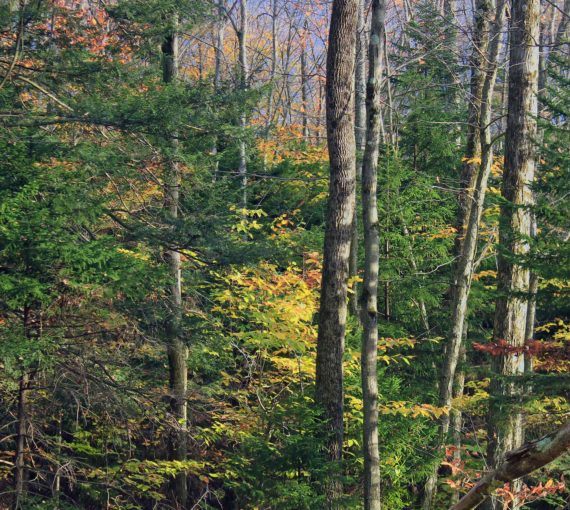
A core tenet of just policy-making — particularly in resource development — is centring communities closest to, or most affected by, the policy’s impacts. That’s the issue at play in the conversation around ownership and control of industrial logging practices in Canada — especially as the logging industry is such a big economic player. In the current climate of national financial and local job insecurity, the ongoing biodiversity crisis and the recent announcement of financial aid in response to United States tariffs, this issue warrants a closer look.
If we want financial security, we must not draw down our resources
It’s important to note that, unlike fossil fuels, trees do not take thousands of years to regenerate. Forests can be truly sustainable, if managed properly.
However, throughout Canada, overharvesting and harmful logging practices are degrading forest integrity, drawing down forest resources and threatening long-term economic resiliency. For example, a recent paper highlights how cumulative impacts of industrial logging in Ontario and Quebec have altered forest structure, while British Columbia is facing a significant decline in timber supply due to decades of overharvesting old growth.
The value of forests
Healthy forest ecosystems support current and future jobs in the logging industry, store carbon in the soil, help mitigate against floods and filter air and water, and provide habitats for wildlife species such as wolverine, pine marten, boreal caribou and thousands of birds.
But saying that forests support wildlife doesn’t tell the whole story. Wildlife also support forests. Their symbiotic relationships, emergent over millennia, play a critical role in shaping forest structure and composition (think seed dispersal and/or insect reduction from birds, or how animal scat returns nutrients to the soil).
Who controls and/or benefits from practices in Canada that degrade forests?
Provincial and territorial governments approve Canadian logging practices and develop policies and laws guiding forestry practices. Typically, they benefit from industrial resource extraction activities through royalties. Forestry companies also influence logging practices through federal and provincial lobbies. Many, if not most, operating in Canada are not Canadian-owned. For example, Domtar, one of the largest pulp producers in the world, controls 20 million hectares of boreal forest in Ontario and Quebec and is owned by Paper Excellence, a sister company of Asia Pulp and Paper, which is controlled by the Indonesian conglomerate Sinar Mas.
At the end of March, Alberta approved additional logging by the American-based company Weyerhauser in the habitats of two caribou herds already highly imperiled from industrial disturbance, which conservationists say will lead to their local extinction. To some, local extinction of a Canadian icon (caribou grace our quarters) by an American company seems offside.
Who’s calling for change?
It’s no surprise that conservation organizations such as the David Suzuki Foundation are calling for change to lessen the ecological impacts caused by status quo logging operations. What’s notable is that these calls are also coming from forestry workers and/or the unions that represent them. For example, when the lack of sufficient provincial measures to safeguard boreal woodland caribou habitat in Quebec brought about the possibility of federal government intervention, four unions representing forestry workers united and issued a statement that, in part, called on the Quebec government to “take the issue seriously and implement an organized, smart plan, to protect woodland caribou, ensure a sustainable future for the forestry industry and adequately support the workers who make it prosper.”
Conservation organizations are generally not opposed to logging, but would rather see practices that leave healthy forests. This is partly about setting limits (limits to facilitate caribou survival, identified by the federal recovery strategy, exist, but are ignored by most provinces).
Planning for the long-term health and sustainability of Canadian forests is the best way to support ecosystem integrity and the forestry industry. In a joint press release in response to impending tariffs, 14 environmental organizations declared that public funding should support forestry workers directly and focus on “wage protections, retraining programs, and investments in sustainable practices that create stable, well-paying jobs while maintaining and restoring forest ecosystem health.”
What would change look like?
Although the Forest Products Association of Canada has, in the face of the potential tariffs, called for “Cut[ting] Red Tape and Regulatory Barriers,” Canada will not achieve resilience if it follows the Trump administration’s deregulation agenda of expanding logging’s reach. Systemic change is needed to develop ways of logging that maintain and restore forests rather than further degrading them.
Forestry should shift so that local communities and Indigenous Peoples have more say in management practices. Provinces should transparently report on and develop strategies to reduce influence and control over forests from outside Canada. First Nations leadership and consent must be central to forest policy decisions.
Canada should reap far more value from forest products before they’re shipped to other countries, so profits aren’t exported alongside timber. The pulp and paper sector’s decline means some forest fibre could be dedicated to value-added products such as engineered beams and lumber. Domestic sources of these materials would employ more people in Canada and help provide materials necessary to rapidly build the mid-rise housing stock desperately needed in towns and cities throughout the country.
We must not let uncertainty and fear lead to further forest exploitation in Canada. Instead, let’s reshape forestry practices to redress degradation, ensure workers rather than executive salaries are supported and increase regional production opportunities and decision-making.



